LAWN PHIX PRO PICK
After extensive testing, Drive XLR8 came out on top. The liquid form is easy to pour, and its measurement and application are a breeze. I sometimes mix it with Empero to target grassy weeds like nutsedge or combine it with On Deck to take out broadleaf weeds like dandelion. Use 1.45 ounces per gallon of water and watch the results roll in.
Crabgrass breakthrough is simply inevitable, whether you spot it along your driveway or cropped up around frequently-edged landscapes. If it’s not properly killed with crabgrass preventers, it’s sure to get out of hand.
I’ve treated hundreds of acres of lawns with many different post-emergent crabgrass herbicides. But I wondered: which ones actually got the job done, and which ones were mostly just packaging?
I decided to test the effectiveness of these herbicides by applying them to my crabgrass and documenting the results.
After years of empirical testing and photo collecting, I’m sharing my conclusive results.
The top five liquid crabgrass killers are:
- Drive XLR8 Herbicide Crabgrass Killer: Best Overall Crabgrass Killer
- Acclaim Extra: Best For Killing Larger Crabgrass
- Tenacity Herbicide: Best For Killing Younger Crabgrass
- Quinclorac 75 DF: Best Affordable Crabgrass Killer
- Q4 Plus Turf Herbicide: Best Broad-Spectrum Crabgrass Killer
In this guide, I’m diving into everything you ever needed (or wanted) to know about these five crabgrass killers. I’m also showing the results of my extensive testing so you can see the pictures for yourself.
Table of Contents
Top Crabgrass Killers Explained
I got excellent results from all the crabgrass killers on this list.
Let’s get kicked off with the best overall product:
1. Drive XLR8 Herbicide Crabgrass Killer
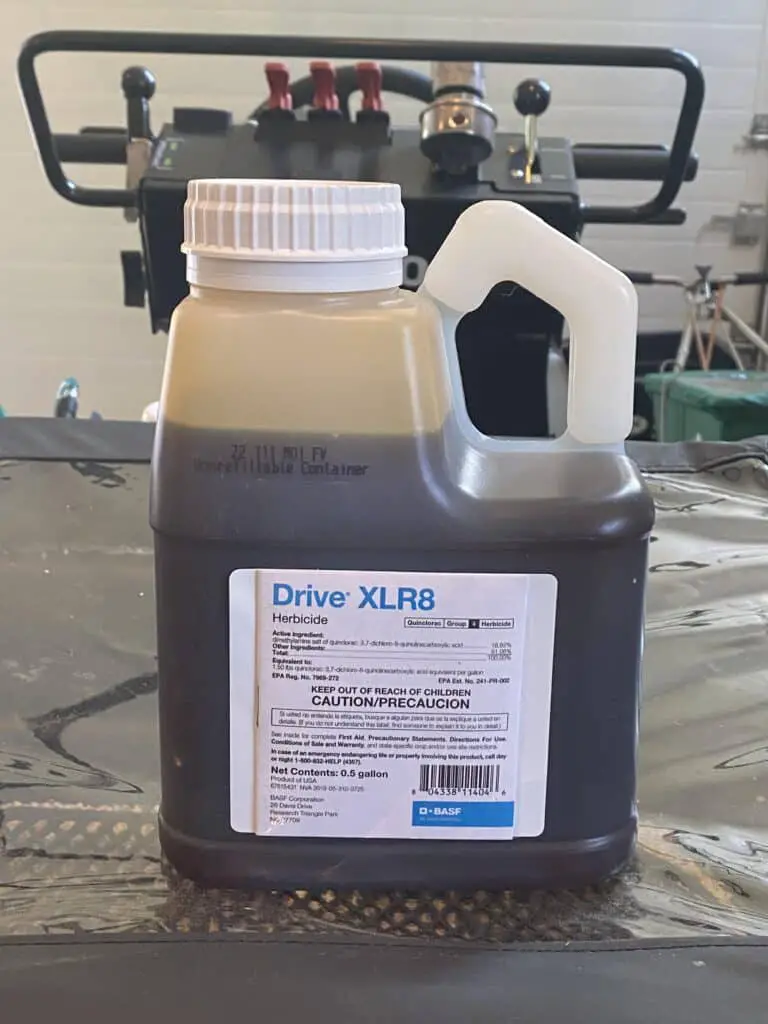
Drive XLR8 Herbicide Crabgrass Killer is one of the highest-rated, best-selling crabgrass herbicides on the market today. It contains over 18% quinclorac as the main active ingredient, undeniably the best herbicide to kill crabgrass plants in over three tiller stages. It is also labeled for many other weeds like white clover, dandelion, Kikuyu grass, and more.
Lawn Phix Review
Drive is the only crabgrass killer I use for my customers and the #1 product I recommend. I experience more crabgrass on new client lawns, and I generally only need to apply one application of Drive XLR8 – even for mature crabgrass plants in the 4+ tiller stage.
Drive recommends using methylated seed oil (MSO) as a carrier, but since crabgrass generally thrives in the summer, I find this mixture too “hot” and too susceptible to burning good turf. Instead, I lower the pH of my tank water to about 5.0 pH and use Induce pH non-ionic surfactant (NIS) for better (and safer) results.
I sometimes mix Drive XLR8 with Empero (or Sedgehammer) to target crabgrass and nutsedge. These two weeds are prominent during the summer months, so it’s a perfect 1-2 punch.
While the $70 price tag may seem high upfront, the price per application is still quite low. Including a surfactant, this only costs around $1.60 per gallon. I’ve never found a product that tops it!
PROS
What we liked.
- Shows visible effects on crabgrass within one week
- Low cost per application
- Can be easily mixed with some broadleaf herbicides
CONS
What we didn’t like.
- Unpleasant smell
- No measuring cup
- Not labeled for all warm-season grasses
Drive XLR8 Herbicide Crabgrass Killer Application Rates
- Apply 1.45 fluid ounces of Drive XLR8 per 1,000 square feet
- Do not mow two days before or after applying Drive XLR8
- Do not water or irrigate for 24 hours after application
- Do not apply to fine fescue unless it’s part of a blend
- One-half gallon (64 oz.) covers one acre of established turf
- Labeled for Bermuda Grass, Buffalograss, and Zoysia (warm-season grass type)
- Not labeled for St. Augustine, Centipede grass, or Bahiagrass (warm-season grass type)
Drive XLR8 Herbicide Crabgrass Killer Specifications
- Active ingredient: 18.92% Quinclorac
- Application: Backpack sprayer
- Coverage: Up to 128,000 square feet
- Product size: 64 ounces (½ gallon)
- Rates: 0.5 and 1.45 fluid ounces per 1,000 square feet
- Type: Liquid
- Use in: Bermuda grass, Kentucky bluegrass, Buffalo grass, Fescue, Ryegrass, Zoysiagrass
- Weeds targeted: Crabgrass, torpedograss, kikuyugrass, clover, speedwell, and more
Drive is best used when with a Methylated Seed Oil (MSO), but as I mentioned before, a NIS works just as well for me.
Find Drive XLR8 at Do My Own, Lawn Pro, and Amazon.
Before and after photos of testing Drive XLR8; images are seven days apart. This was from a new customer’s lawn in Franklin, MA. The previous lawn care company attempted to seed in late June – the worst time to seed cool-season lawns, particularly in the Northeast. You can see hoe big and mature these crabgrass plants were. Within a week there was visible damage on more than half the plant. A second application two weeks after the first completely cleared this area of crabgrass and weeds.
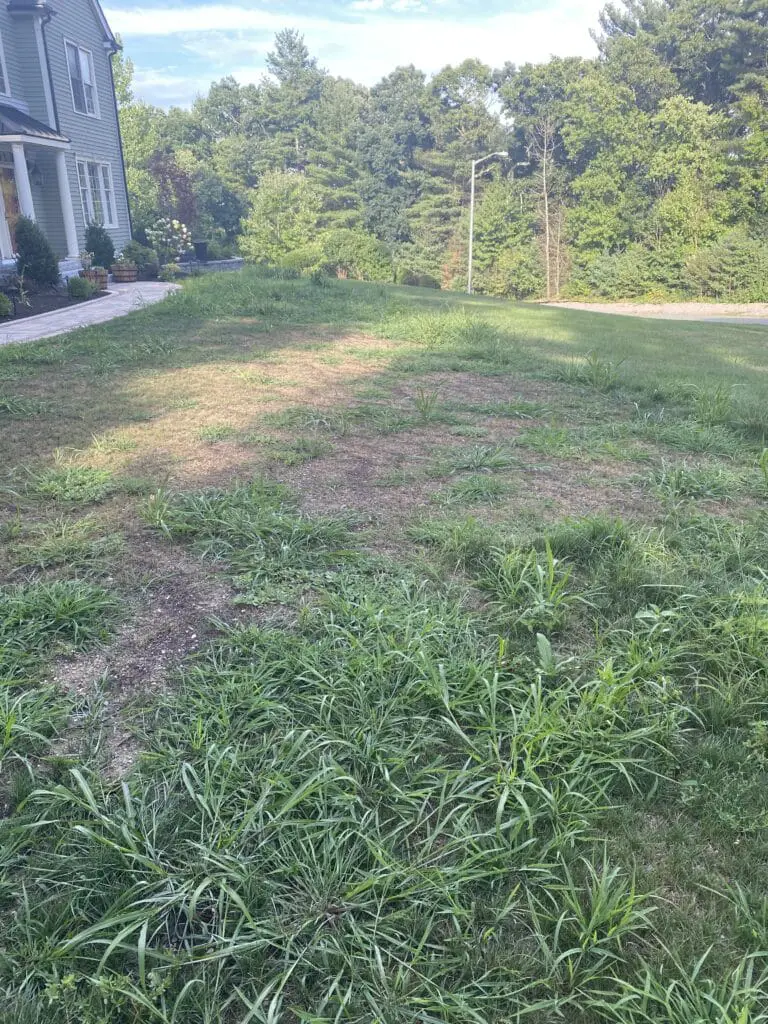
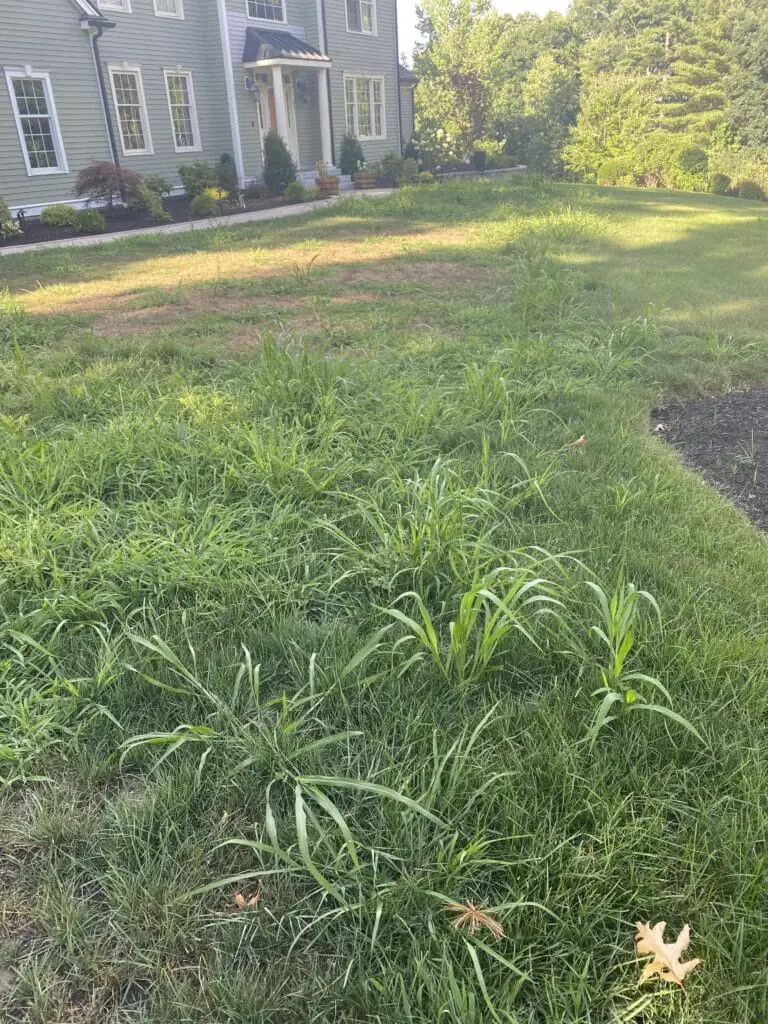


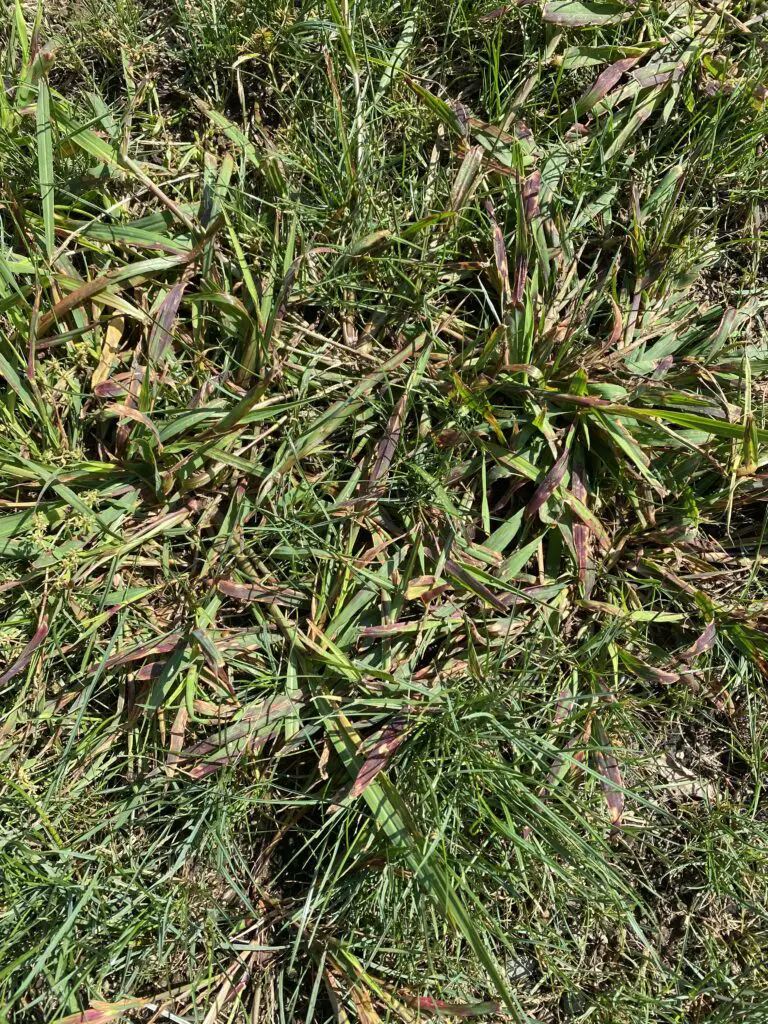
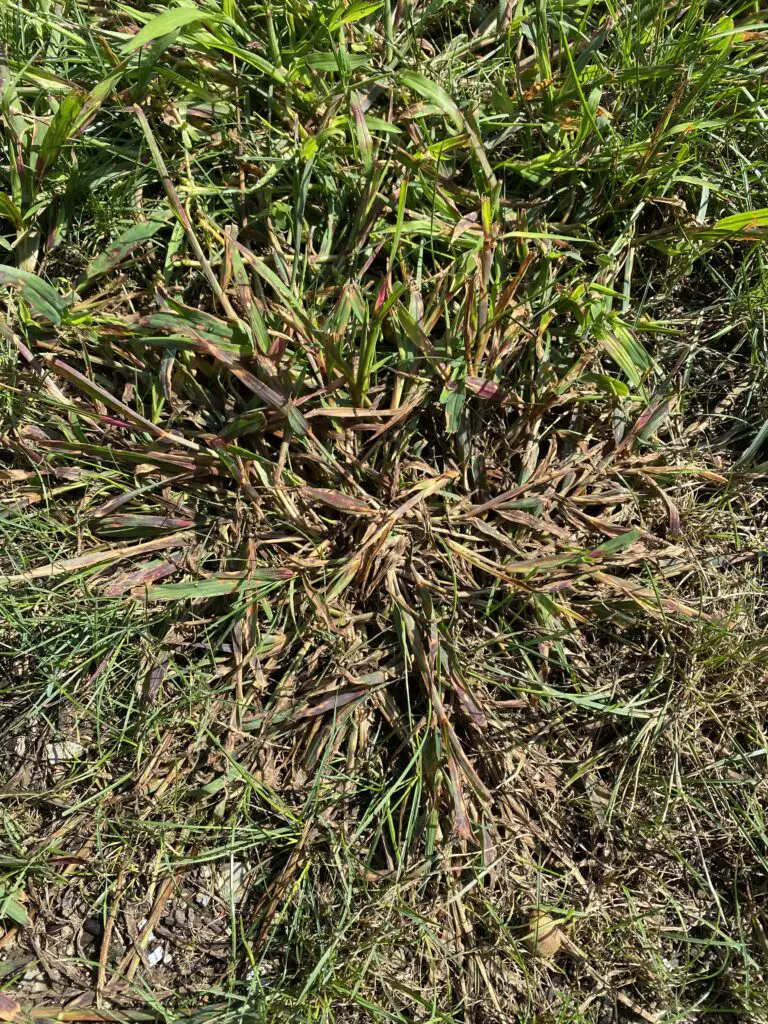

2. Acclaim Extra

Acclaim Extra Selective Herbicide is a post-emergent herbicide containing the active ingredient Fenoxaprop-p-ethyl. Although it controls all stages of crabgrass, it does its best job on large crabgrass plants at the 4-tiller stage (and larger). If you have well-established crabgrass in your yard, this is the herbicide for you.
Lawn Phix Review
The higher price tag, albeit with great results, makes Acclaim Extra #2 on my list. A pint will treat up to 34 gallons, but I don’t see the benefit of spending more than 2x the cost of Drive XLR8 (a little more than $3.50 per gallon with NIS).
All that said, Acclaim Extra is an effective crabgrass killer and makes a nice backup to Drive XLR8.
Side note: I’ve used this with excellent results on Japanese stiltgrass. If you’re fighting both of these aggressive plants, this might be the product for you.
PROS
What we liked.
- Works best on more extensive and more mature crabgrass plants
- Low application rates (under 1 oz.)
- It can be easily mixed with some broadleaf herbicides
CONS
What we didn’t like.
- The most expensive option
- Wait 2-3 months before applying to new KBG grass.
Acclaim Extra Application Rates
Acclaim Extra’s application process depends on the growth stage of your crabgrass.
You can use this chart to determine what that is:
| CRABGRASS GROWTH STAGE | FL. OZ / 1,000 SQ. FT |
| Untillered | 0.30 |
| 1-2 tiller stage | 0.46 |
| 3-4 tiller stage | 0.64 |
| 4-5 tiller stage | 0.90 |
What does the term ‘tiller’ mean in the context of crabgrass? This video from Do My Own Lawn Care is amazingly informative:
Do My Own Lawn Care – Talking Tiller Stages
Acclaim Extra Specifications
- Active ingredient: 6.59% Fenoxaprop-p-ethyl
- Application: Backpack sprayer
- Coverage: Roughly 34,782 square feet
- Product size: 16 ounces
- Rates: Apply 0.46 ounces to every 1,000 square feet
- Type: Liquid
- Use in: Warm-season grasses (Bermuda Grass and Zoysia)
- Weeds targeted: Barnyardgrass, crabgrass, goosegrass, foxtail, panicum, johnsongrass (seedling), sandbur, sprangletop, and japanese stiltgrass
Find Acclaim Extra at Do My Own, Lawn Pro, and Amazon.
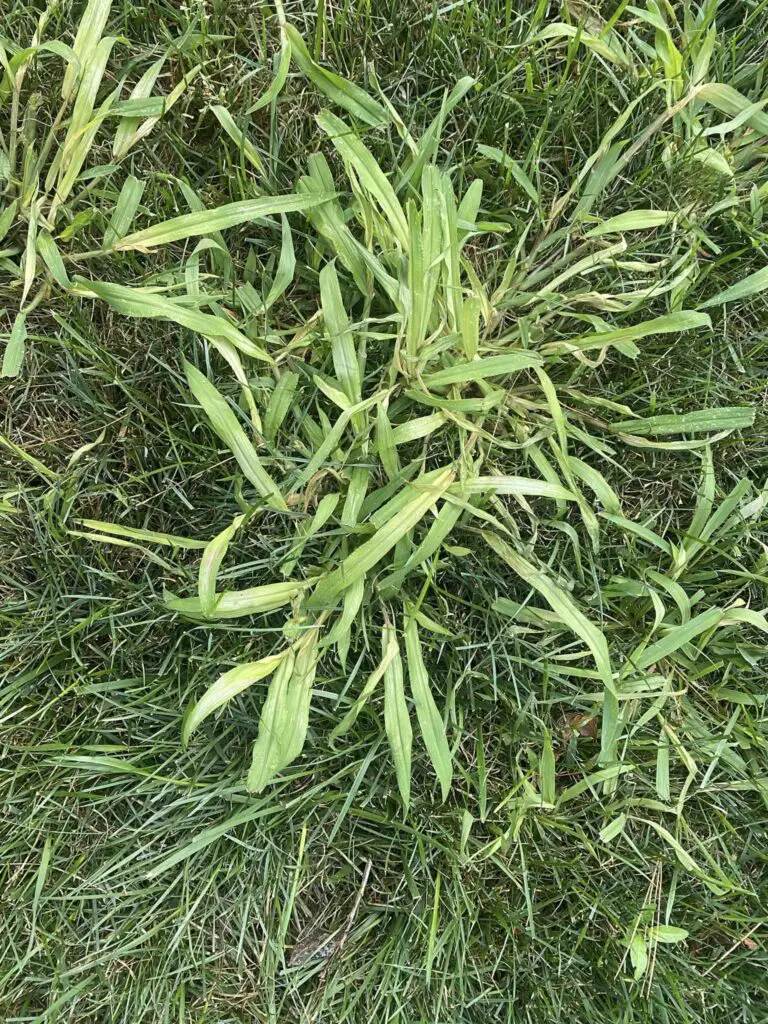
3. Tenacity Herbicide

Tenacity Herbicide is extremely effective on younger, more tender crabgrass. This remarkable product contains Mesotrione as its main active ingredient — one of very few herbicides that are safe to apply at seeding.
You should bleach your one-to-three tiller stage crabgrass within one week of applying Tenacity. However, you may need a second application two weeks later depending on the severity of your infestation.
Lawn Phix Review
I love how little Tenacity turf herbicide is needed per application. Measuring with a syringe can get messy, so I recommend wearing gloves.
Update: there is finally a new squeeze/pour measuring bottle, so you no longer have to fumble with the syringe.
It took two applications for me to kill crabgrass completely. The visual bleaching effects weren’t noticeable until about day seven.
Overall, this is an excellent versatile herbicide easily mixed with Speedzone to create a great “cocktail” against grassy and broadleaf weeds. It’s also good to have on-hand in the event you need to overseed in spring.
But in the end, I think Mesotrione is best used for killing bentgrass in your yard.
PROS
What we liked.
- Works well on small, young crabgrass.
- Very low toxicity and application rates.
- Does not interfere with seeding/overseeding.
CONS
What we didn’t like.
- It can cause temporary bleaching of good turf.
- When used as a pre-emergent during seeding, the efficacy will last approximately 30 days.
- It takes the longest to eradicate crabgrass.
Tenacity Herbicide Specifications
- Active ingredient: 40% Mesotrione
- Application: Backpack sprayer
- Coverage: Up to 87,120 square feet
- Product size: 8 ounces
- Rates: 4 to 8 ounces of product per 30 gallons of water per acre
- Type: Liquid
- Use in: Kentucky Bluegrass, Centipedegrass, Buffalograss, Tall Fescue, Perennial Ryegrass, Fine Fescue, and sod-only St. Augustine Grass
- Weeds targeted: Crabgrass, barnyardgrass, carpetweed, chickweed, clover, dandelion, goosegrass, foxtail, henbit, yellow nutsedge, purslane, thistle, wild carrot, and more
Find Tenacity at Do My Own, Lawn Pro, and Amazon.

4. Quinclorac 75 DF
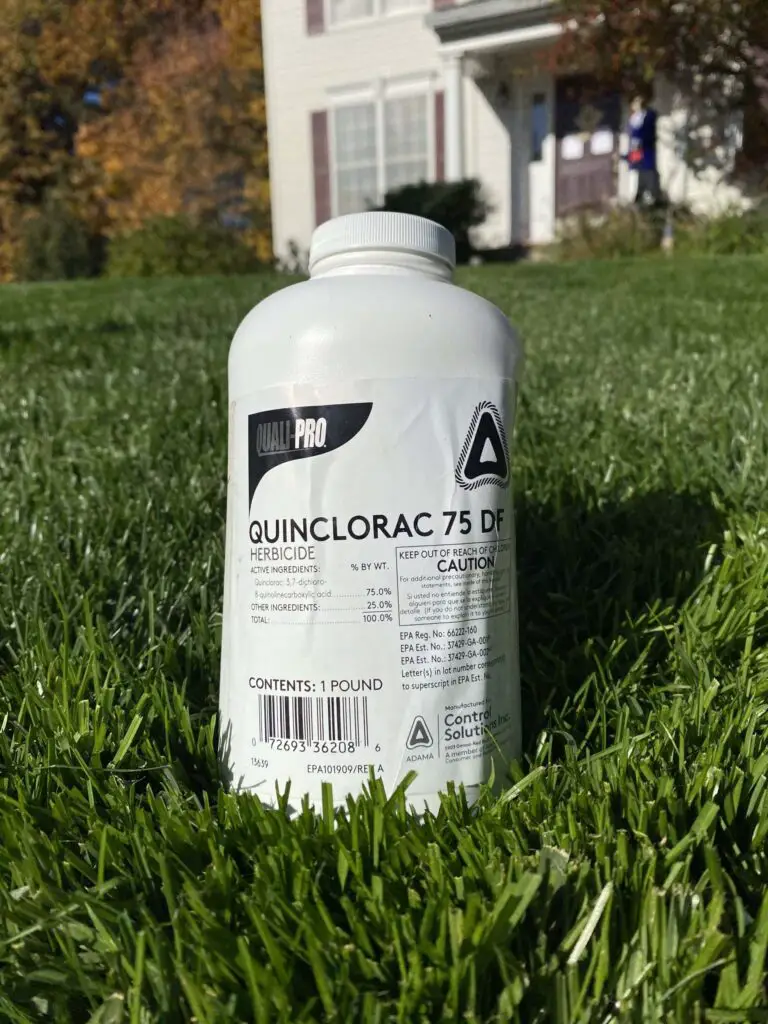
Quinclorac 75 DF is my top choice for an affordable crabgrass killer and control. The “75” refers to the 75% active ingredient, quinclorac. The “DF” stands for ‘dry flowable,’ which is a granular product that makes a great liquid sprayable herbicide.
Like a few other entries on this list, Quinclorac 75 DF kills crabgrass best with a non-ionic surfactant (NIS).
Lawn Phix Review
The Quinclorac 75 DF worked quickly on the crabgrass. The measurement was trickier, though. The dry flowable ‘pellets’ needed more attention to detail than your average liquid product.
I was conscious of shaking the sprayer constantly to suspend the chemicals in the tank. You can see I needed two applications, but it got the job done nonetheless.
Overall, Quinclorac 75 DF is the best option for those on a more strict budget who don’t mind weighing out the solid product and mixing.
You can also buy Quinclorac in 1.5 L liquid, too. A great, affordable option that kills crabgrass exceptionally.
PROS
What we liked.
- The cheapest and most affordable option.
- High concentration of quinclorac, so it requires a low mix rate.
- Can be mixed with some other broadleaf weed killers.
CONS
What we didn’t like.
- It must be weighed out using a scale or accurately measured using a specific measuring cup (included).
- If not dissolved and broken down properly, pellets may clog the nozzle of the sprayer.
- The Dry-Flowable needs to be dissolved thoroughly. If not, it may not suspend properly, which may cause the product to spray an inaccurate ratio of active ingredients.
Quinclorac 75 DF Application Rates
Dissolve one tablespoon per gallon of water, then apply this product directly to your crabgrass.
Quinclorac 75 DF Specifications
- Active ingredient: 75% Quinclorac
- Application: Backpack sprayer
- Coverage: 43,560 square feet
- Product size: One pound
- Rates: 1 tablespoon per gallon of water for every 1,361 square feet
- Type: Granular (liquid form available)
- Use in: Most residential and commercial lawn APART FROM Bahiagrass, Colonial Bentgrass, Seaside Bentgrass, Centipedegrass, Dichondra, and St. Augustine grass
- Weeds targeted: Crabgrass, Clover, Foxtail, Dandelion, Black Medic, English Daisy, Morning Glory, Dollarweed, Speedwell, Torpedograss, Kikuyu Grass, Barnyardgrass, Bindweed, Signalgrass, and Violet
Find Quinclorac 75 DF at Do My Own, Lawn Pro, and Amazon.
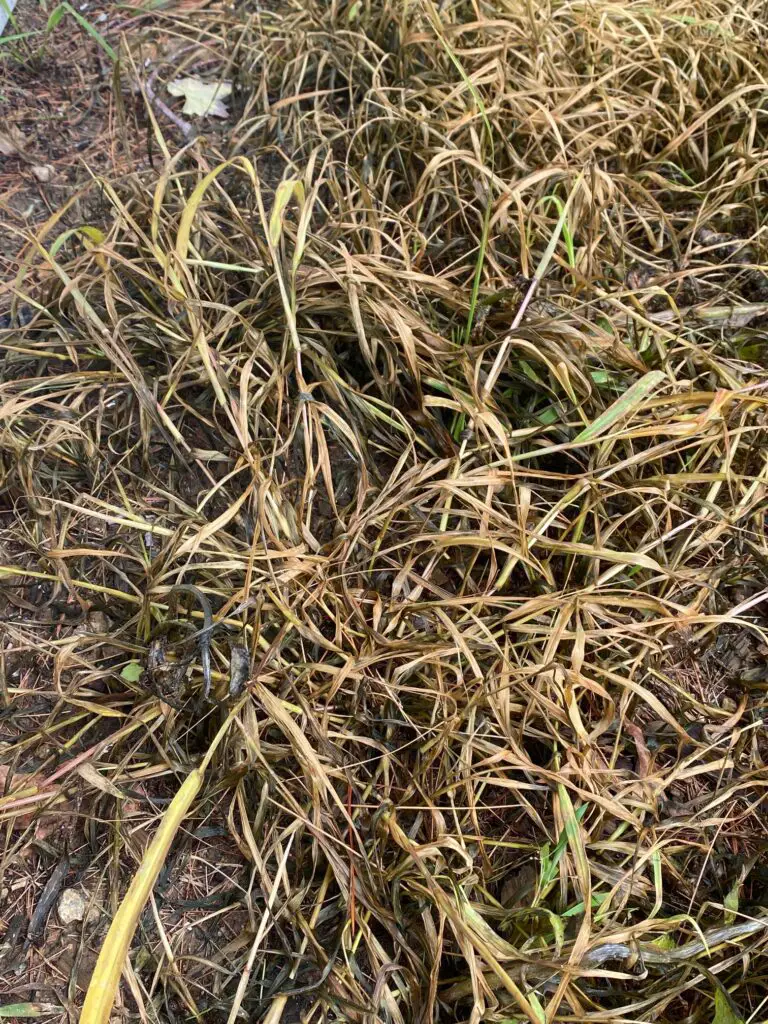
5. Q4 Plus Turf Herbicide
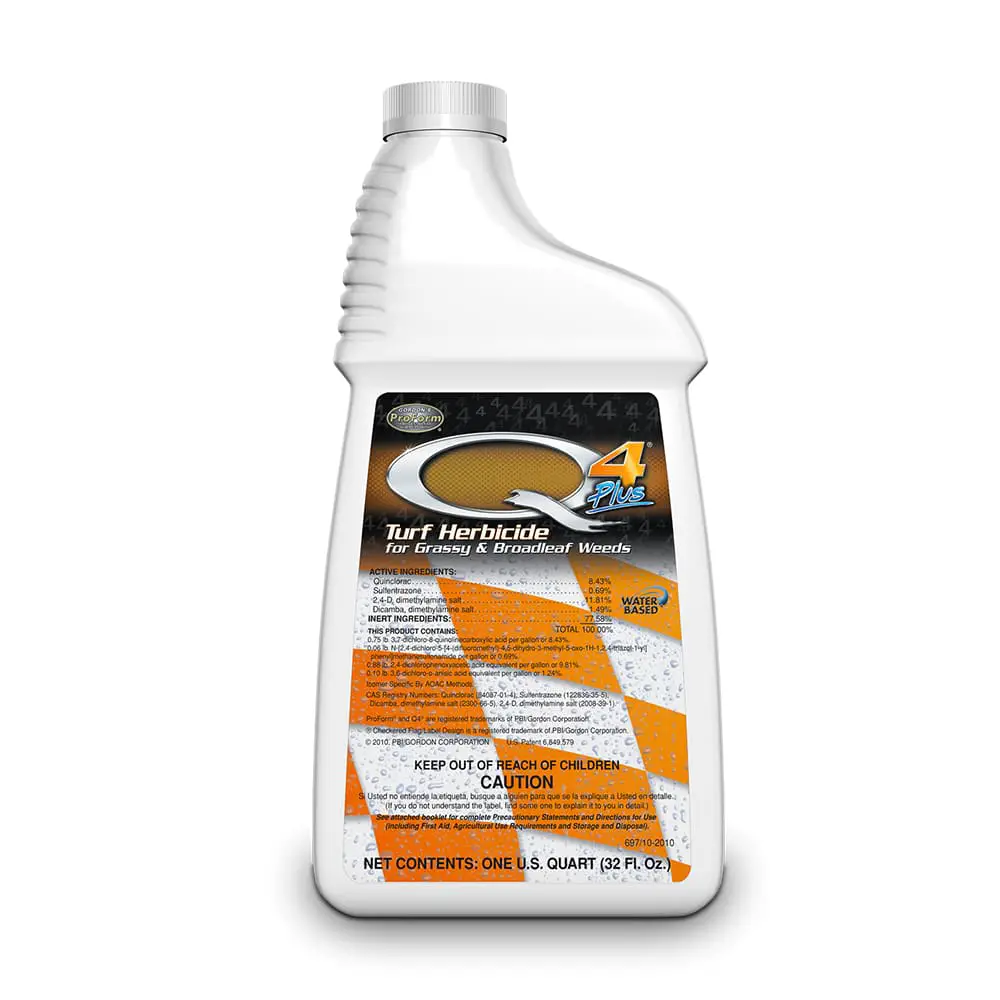
Q4 Plus Turf Herbicide is a decent crabgrass killer and all-around herbicide to have on hand. It’s a 4-way herbicide containing quinclorac, sulfentrazone, 2,4-D (dimethylamine salt), and Dicamba. This combo is designed to treat crabgrass, yellow nutsedge, and a long list of commonly found broadleaf and grassy weeds.
PROS
What we liked.
- A versatile broad-spectrum weed killer.
- It also works on nutsedge and broadleaf weeds.
CONS
What we didn’t like.
- Requires multiple applications for crabgrass.
- High use rates (3 oz. per gallon).
Find Q4 at Do My Own, Lawn Pro, and Amazon.
Q4 Plus Turf Herbicide Application Rates
For broadcast and spot treatments of Q4 Plus Turf Herbicide, use 2.6 to 3.0 ounces of product per gallon per 1,000 square feet. This rate costs about $1.70 per application, which is relatively cost-effective.
Q4 Plus Turf Herbicide Specifications
- Active ingredient(s): 11.81% dimethylamine salt, 1.49% dimethylamine salt, 8.43% quinclorac, and 0.69% sulfentrazone
- Application: Backpack sprayer
- Coverage: Up to 17,777 square feet
- Product size: 32 ounces
- Rates: 2.6 to 3.0 ounces of product per gallon per 1,000 square feet
- Type: Liquid
- Use in: Most cold and warm season grasses
- Weeds targeted: Crabgrass, Barnyard grass, Bull Thistle, Chickweed, Clovers, Crabgrass (large & smooth), Dandelion, Nutsedge, and Signalgrass
View Crabgrass Killers on Amazon
Crabgrass Killer FAQs
What kills crabgrass without killing grass?
When used as directed according to the label, these five crabgrass killers can kill crabgrass at many tiller stages without harming good turf. Chemicals like Fenoxaprop-p-ethyl (Acclaim) and Quinclorac (Drive XLR8) are very effective. Mesotrione (Tenacity) is effective at killing and preventing crabgrass but may temporarily bleach your good grass.
Is crabgrass an annual, biannual, or perennial weed?
Crabgrass is an annual grassy weed and a plant that produces seeds. As crabgrass matures in the summer, it goes to seed and dies off. Seeds overwinter then germinate when soil temps reach 55 degrees. They then emerge as young crabgrass to start the cycle all over again.
When should I put down crabgrass killer?
Always follow the manufacturer’s directions on the labels. If you missed the pre-emergent window and see crabgrass in the spring, it’s best to attack the plant while it is in an early tiller stage. You can spray again into the summer, but follow the application rates/intervals, maximum dosage, and outside temperature warnings (generally under 80-85 degrees).
Will pre-emergent herbicides kill crabgrass?
Yes and no.
When applied early and correctly, crabgrass pre-emergents prevent seeds from sprouting in your lawn.
But if crabgrass is already visible in your lawn, a pre-emergent will not kill it — a post-emergent crabgrass killer is needed.
Images: Lawn Phix Crabgrass Killer Herbicides
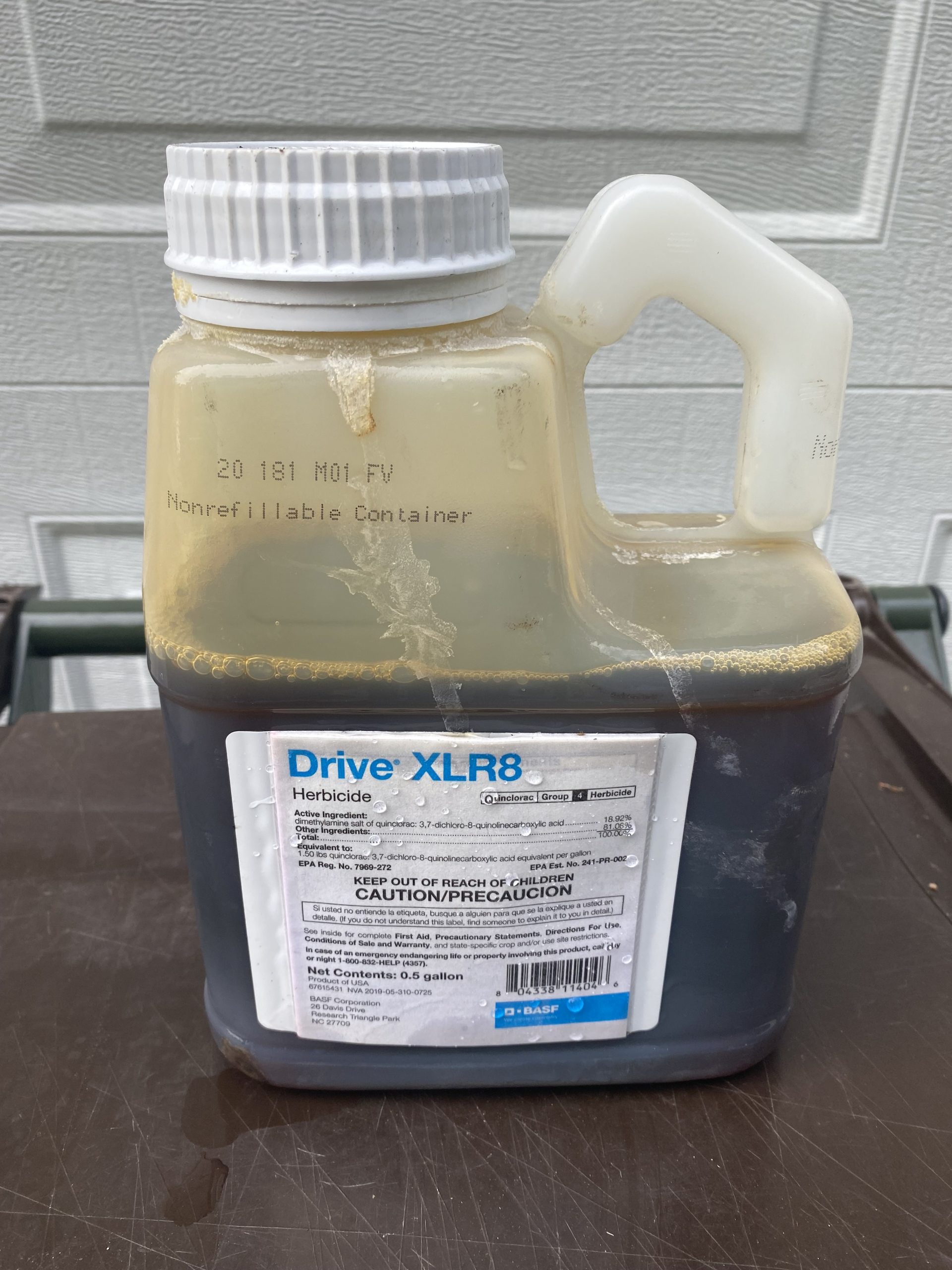
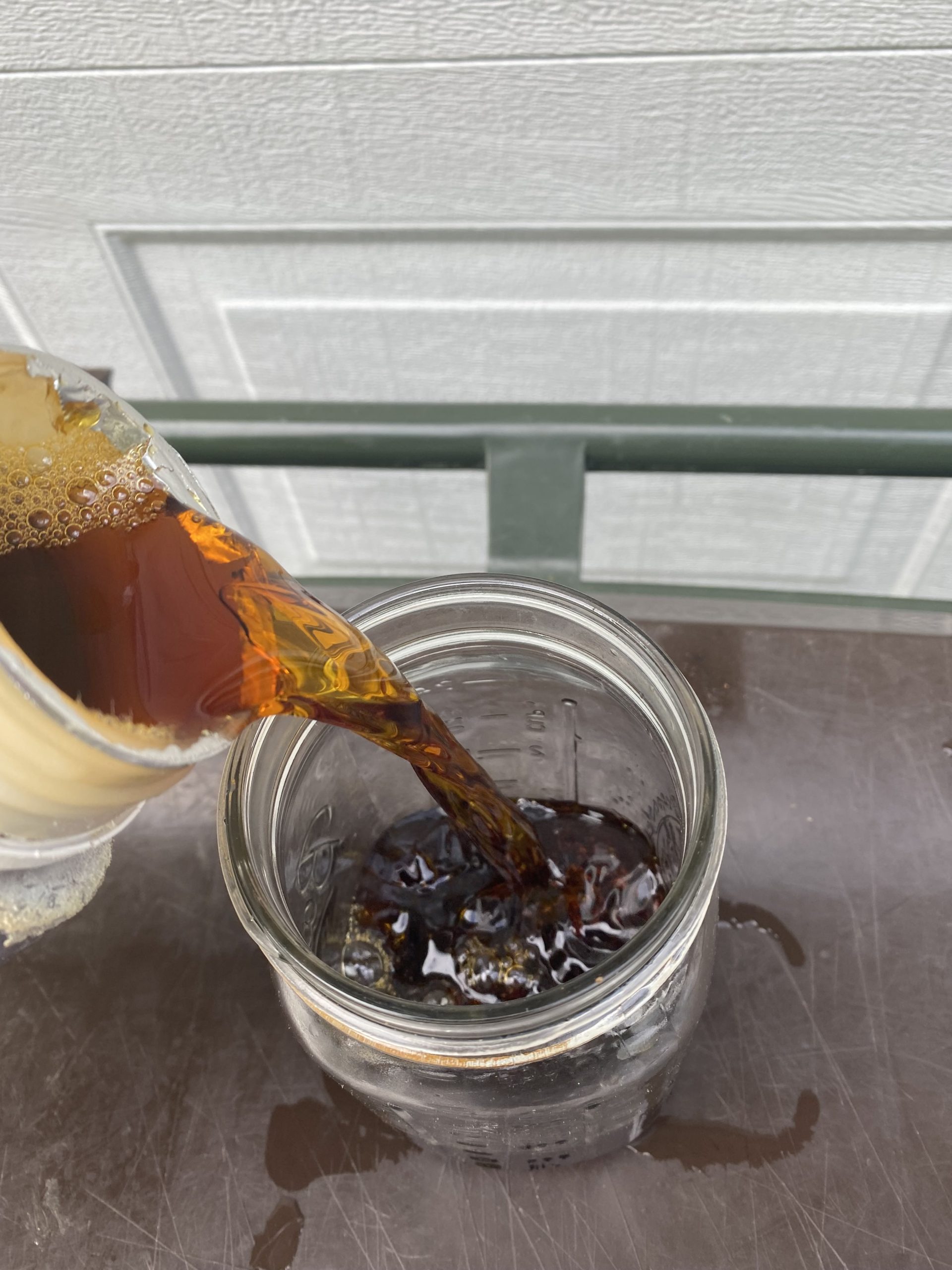
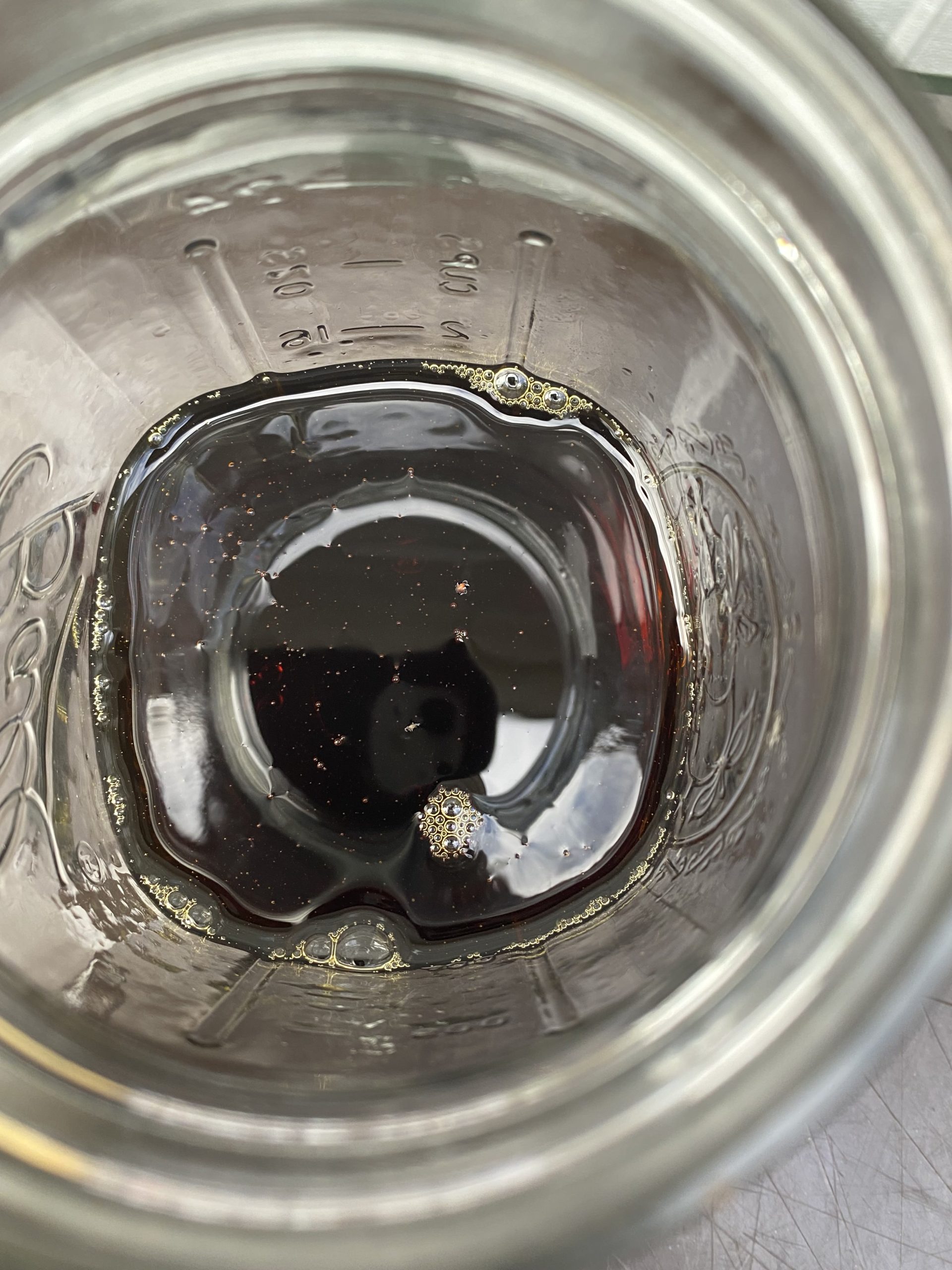
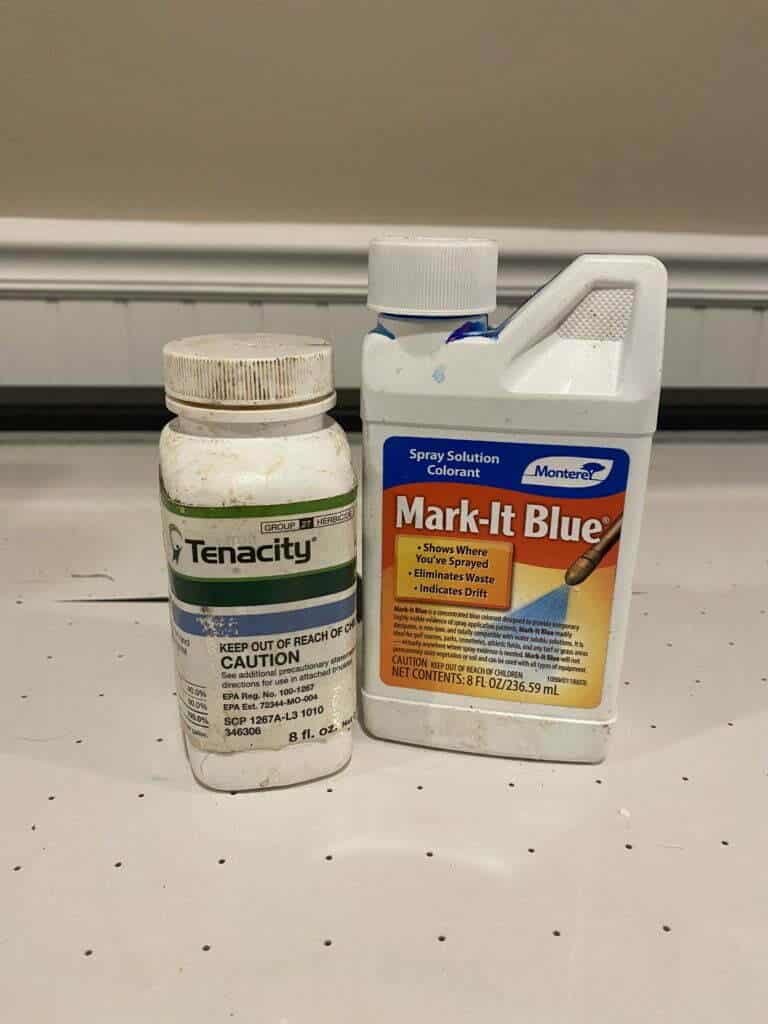
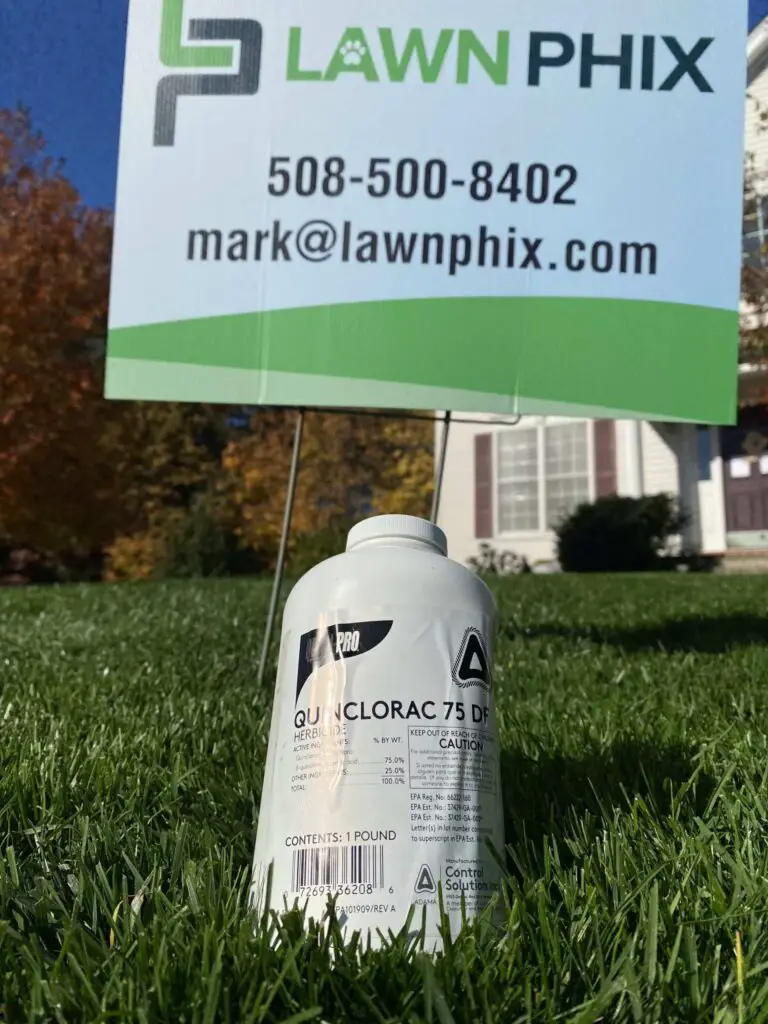
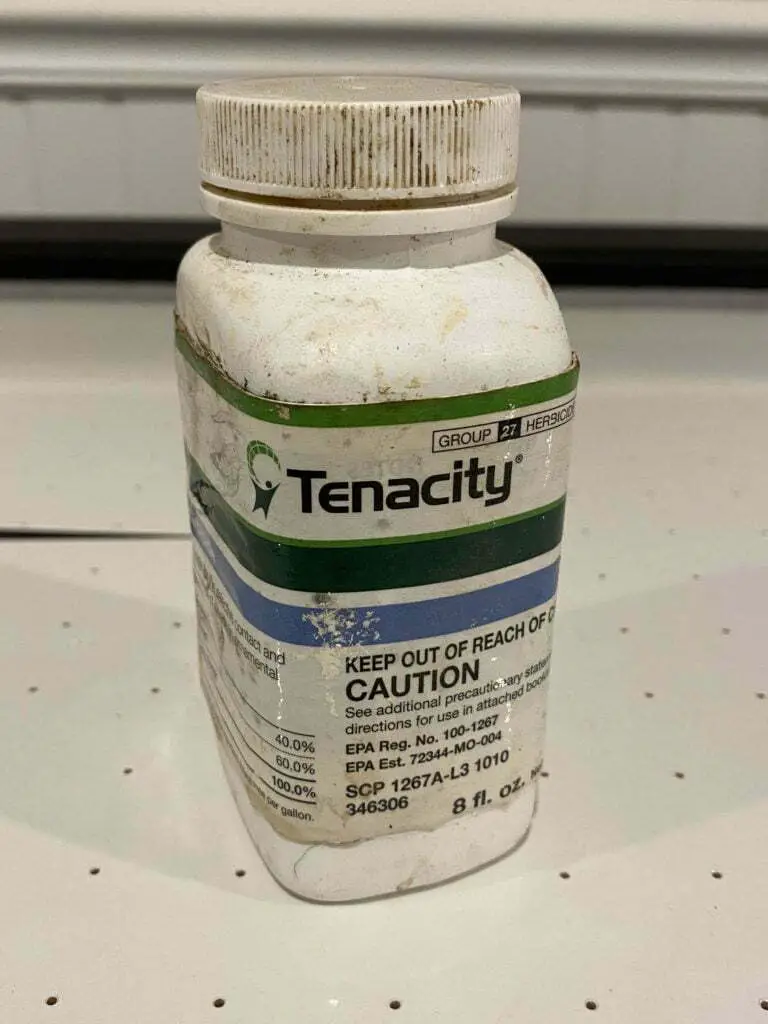
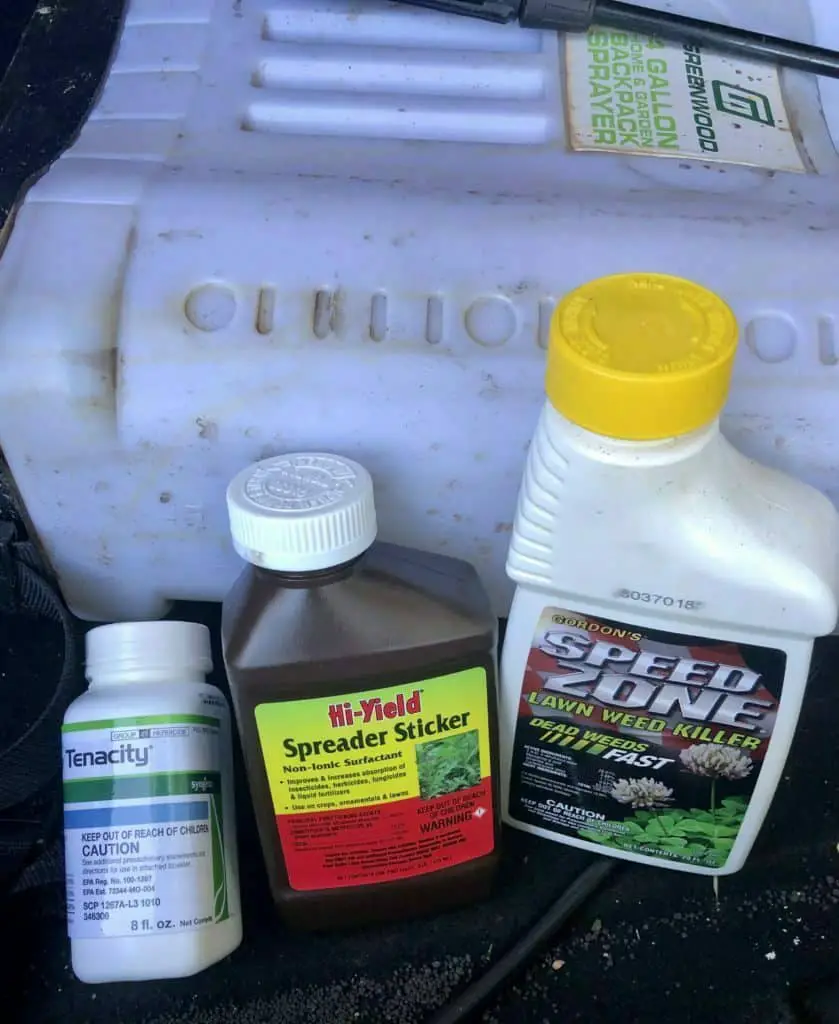
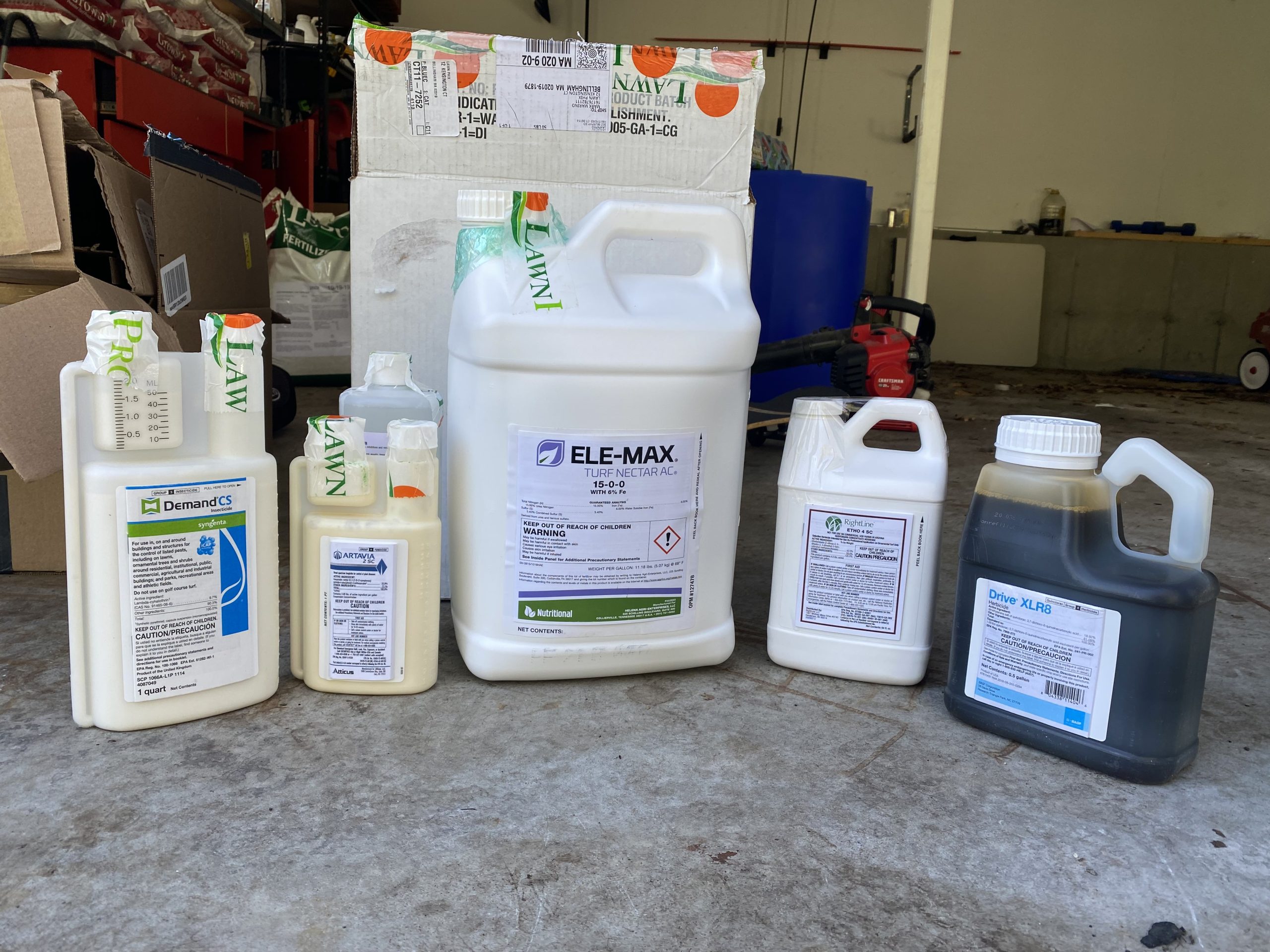
Lawn Phix used crabgrass killer + herbicides

